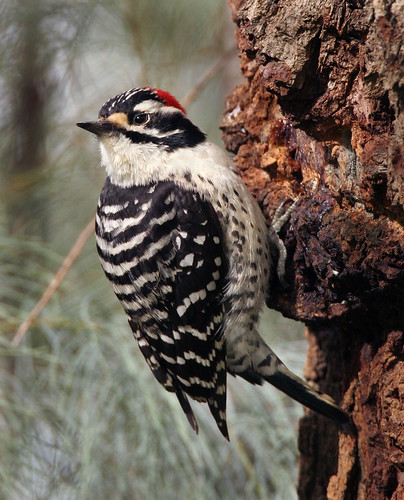
Nuttall’s Woodpecker, Picoides nuttallii
Image Credit: Ron Wolf
I was going over my life list this weekend after my Nebraska and SoCal trips. It turns out that I surpassed 300 species for my US life list. I am now standing at 317 species on my US list, and 472 species on my world list. Although I am making ground, Phoebe Snetsinger
has nothing to worry about.
US species #300 was Nuttall’s Woodpecker. The bird was observed in Big Sycamore Canyon in Point Magu State Park (Ventura, CA). We had just entered the park and were making our way down the main trail toward the camping area. I heard the woodpecker calling, but was unable to locate it. After a few minutes searching, my daughter LeAnn spotted it in a tree a few feet off the road. The bird hung around for several minutes, providing me with some really good looks. I subsequently heard two others about an hour or so later in the same location.
I referenced Wikipedia to get a little background on the bird.
Nuttall's Woodpecker is common in groves of live oak and chaparral west of the Sierra mountains in the state of California and extends south into the top of the Baja California Peninsula of Mexico. It is a small woodpecker about 6 to 7 inches in length. It is primarily colored black and white, with a barred pattern across its back and wings, and a plain black tail. Its white breast is also speckled with black on the flanks and rump. The male Nuttall's also has a red patch on the back of its head. Nuttall's Woodpecker is very similar in appearance to the Ladder-backed Woodpecker, but Nuttall's Woodpecker has more black on the head, face, and upper back, and males have less red on the head. The range of the two species only intersects a minimal amount in southern California and northern Baja California, so misidentification should not be a concern over the majority of their range.
I also referenced the Stanford Birds to get a little life history.
Diet: Insects (80%); also few acorns, sap, occasionally grain. Nuthatch style of gleaning from underside of limbs.
Breeding: Oak woodland, chaparral, riparian (esp willow-cottonwood) woodland; often foothill canyons. Usually nests in dead riparian deciduous tree. Unlined. Excavation ca. 13 days, not reused.
Displays: Mostly territorial: head bobbing and turning, crest raising, bill directing and raising, wing spreading and aerial displays.
Notes: Pairs remain on year-round territories. Male performs most of incubation including all nocturnal incubation and brooding. Preferentially forage on oaks; females forage on smaller branches and twigs more frequently than do males. Occaisonally hybridizes with Ladder-backed and Downy, with which it is especially territorial.



No comments:
Post a Comment